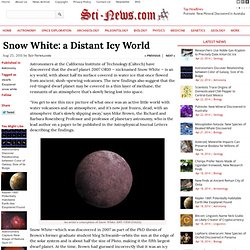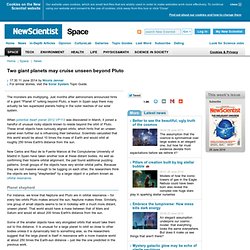

Mercury. Venus. Pole Shift. Moon. Mars. Ceres. Asteroids. Jupiter. Saturn. Uranus. Neptune. Orcus. Pluto. Haumea. Quaoar. Makemake. Sedna. Eris. Earth has Ring Of Anti-Protons. Want to stay on top of all the space news?

Follow @universetoday on Twitter PAMELA team and detector in Rome before launch. Photo courtesy of the PAMELA Experiment When it comes to planets with rings, we know the answer: Jupiter, Saturn, Uranus, and Neptune. But new findings from the PAMELA experiment show that Earth has a ring system, too… One made up of geomagnetically trapped cosmic ray antiprotons. “The existence of a significant flux of antiprotons confined to Earth’s magnetosphere has been considered in several theoretical works.” says team leader, O. The PAMELA experiment – short for Payload for Antimatter Exploration and Light-nuclei Astrophysics – is based on an international collaboration involving about 100 physicists.
From its subdetectors, PAMELA dished up a serving of antiprotons, but it wasn’t an easy job. For 850 days, the detectors collected data and compared it against simulations. Original Story Source: Astrophysical Journal Newsletters. About Tammy Plotner. The 'Voice' of our Earth 3D. Snow White: a Distant Icy World. Astronomers at the California Institute of Technology (Caltech) have discovered that the dwarf planet 2007 OR10 — nicknamed Snow White — is an icy world, with about half its surface covered in water ice that once flowed from ancient, slush-spewing volcanoes.

The new findings also suggest that the red-tinged dwarf planet may be covered in a thin layer of methane, the remnants of an atmosphere that’s slowly being lost into space. ‘You get to see this nice picture of what once was an active little world with water volcanoes and an atmosphere, and it’s now just frozen, dead, with an atmosphere that’s slowly slipping away,’ says Mike Brown, the Richard and Barbara Rosenberg Professor and professor of planetary astronomy, who is the lead author on a paper to be published in the Astrophysical Journal Letters describing the findings. An artist's conception of Snow White 2007 OR10 (NASA) As expected, Snow White was red. Two giant planets may cruise unseen beyond Pluto - space - 11 June 2014. The monsters are multiplying.

Just months after astronomers announced hints of a giant "Planet X" lurking beyond Pluto, a team in Spain says there may actually be two supersized planets hiding in the outer reaches of our solar system. When potential dwarf planet 2012 VP113 was discovered in March, it joined a handful of unusual rocky objects known to reside beyond the orbit of Pluto.
These small objects have curiously aligned orbits, which hints that an unseen planet even further out is influencing their behaviour. Scientists calculated that this world would be about 10 times the mass of Earth and would orbit at roughly 250 times Earth's distance from the sun. Now Carlos and Raul de la Fuente Marcos at the Complutense University of Madrid in Spain have taken another look at these distant bodies. Planet shepherd For instance, we know that Neptune and Pluto are in orbital resonance – for every two orbits Pluto makes around the sun, Neptune makes three. Reference: arxiv.org/abs/1406.0715. Giant Ribbon Discovered at the Edge of the Solar System. + Play Audio | + Download Audio | + Join mailing list October 15, 2009: For years, researchers have known that the solar system is surrounded by a vast bubble of magnetism.

Called the "heliosphere," it springs from the sun and extends far beyond the orbit of Pluto, providing a first line of defense against cosmic rays and interstellar clouds that try to enter our local space. Although the heliosphere is huge and literally fills the sky, it emits no light and no one has actually seen it. Until now. Voyager Spacecraft Enters a Strange, Mysterious Region 11 Billion Miles from Earth. Launched 36 years ago, the Voyager 1 spacecraft speeds a rate of about a million miles a day entering a bizarre and mysterious region more than 11 billion miles from Earth that scientists are struggling to make sense of.

First Images of Our Solar System's Tail Revealed. Astronomers have gotten the first-ever peek at our solar system's tail, called the heliotail, finding that it's shaped like a four-leaf clover, NASA scientists announced today (July 10).

The discovery was made using NASA's Interstellar Boundary Explorer (IBEX), a coffee table-sized spacecraft that is studying the edge of the solar system. "Many models have suggested the heliotail might look like this or like that, but we have had no observations," David McComas, IBEX principal investigator at Southwest Research Institute in San Antonio, Tex., said in a statement.
Meteorite older than Solar System. Organic globules found in the Tagish Lake meteorite fragments may predate the solar system, according to a new U.S. study Credit: University of Calgary SYDNEY: A meteorite discovered in Canada may be older than the Solar System, according to a new U.S. study.

Samples taken from the Tagish Lake meteorite, discovered in 2000, have revealed evidence of organic matter that predates our Sun and Solar System, according to the study, published in today’s edition of the U.S. journal Science. Space School- Solar System. Chap_2_2012_part1. TRUTH! The Earth does not revolve around the Sun - The exposure of hiding - in April 2012. The Earth does not revolve around the Sun - PART 2 -The exposure of hiding - January 2013. Scientist Claims Our Solar System Evicted A Planet So Earth Could Survive.